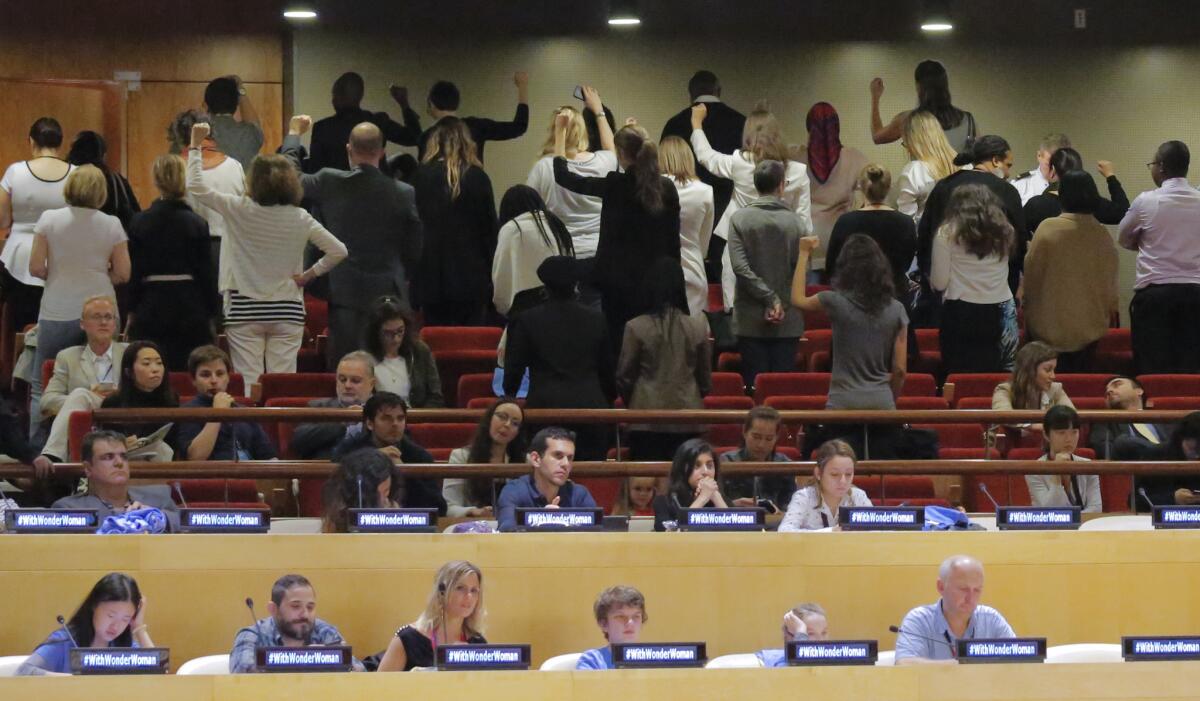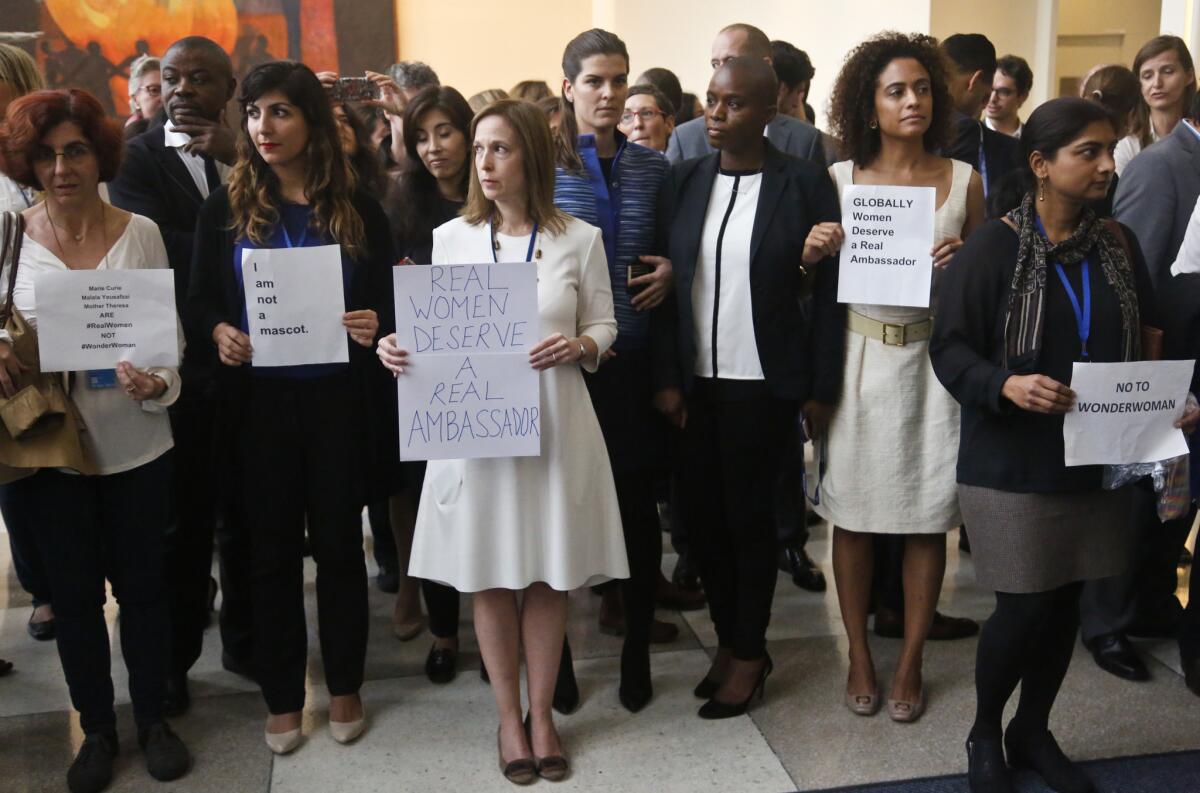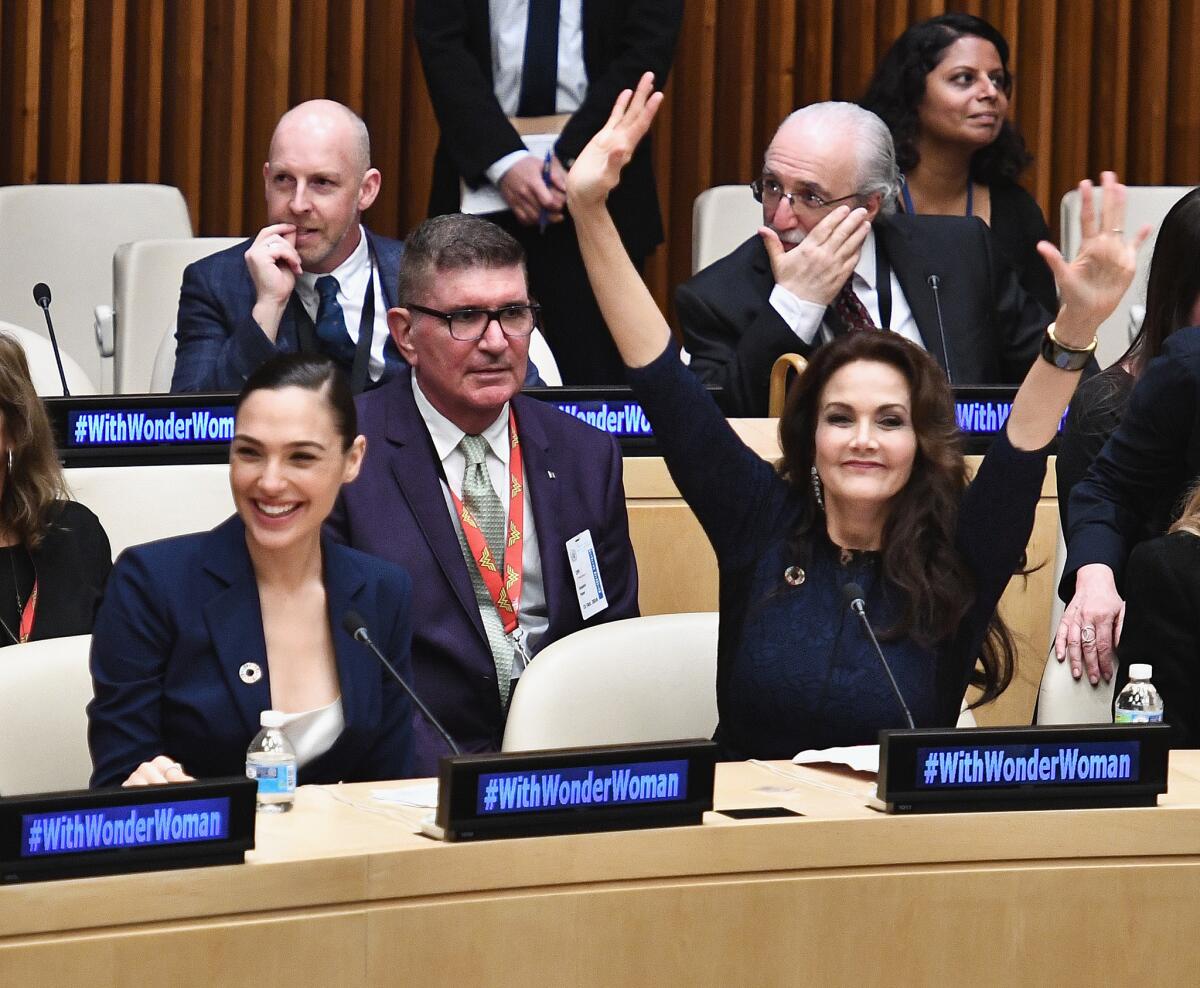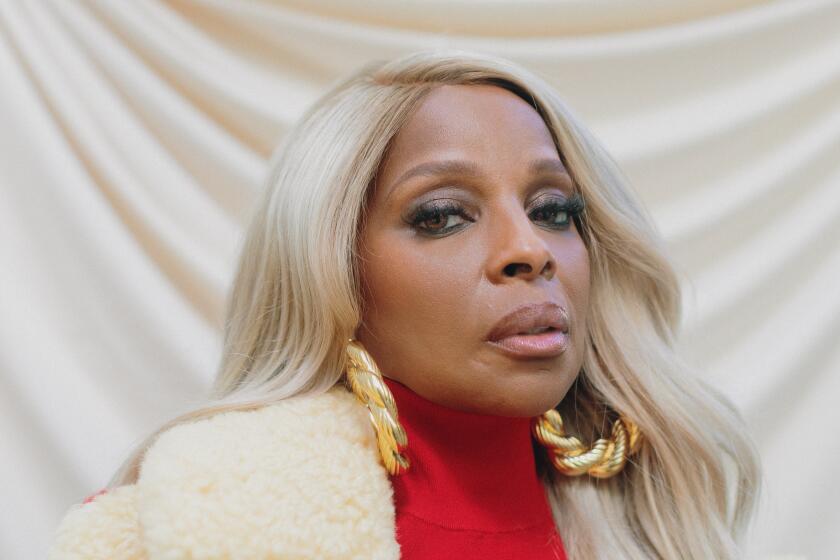At 75, Wonder Woman was just named an honorary U.N. ambassador. But not everyone is happy about that
This is an unparalleled time for women in American history.
The polls are predicting the first female president. Narrowing the wage gap has become part of legislative agendas. Activists are battling against sexual assault and for abortion rights with a fervor not seen in decades, and the glass ceiling is looking more fragile every day.
It is also the 75th anniversary of Wonder Woman.
Coincidence? Perhaps not.
The creation of Dr. William Moulton Marston — a psychologist with broad-minded views on sexual expression whose work as an inventor would lead to the creation of the lie detector — Diana, princess of the Amazonian island of Themyscera, has always stood out.
She isn’t some rich orphan boy turned vigilante like Batman or last son of a dead planet. Wonder Woman is the child of a god. The Amazonian princess first appeared in the eighth issue of 1941 “All Star Comics.” Her nine-page origin story swiftly led to her first cover on “Sensation Comics No. 1” where she appears deflecting bullets from a tommy gun with her now iconic bracelets.
But her weapon of choice is the lasso of truth. A golden rope that forces those constrained to reveal their deepest secrets, the lasso allowed her to right wrongs both as a crime fighter and an instigator of social justice.
A warrior with godlike strength (and a penchant for bondage) she prefers peace and love to war and violence, a contradiction that has long made her a symbol of female empowerment, and the center of controversy.
Even as recently as last week.
As part of her 75th anniversary celebration, Wonder Woman was recently made an honorary United Nations ambassador for the empowerment of women and girls. Last Friday, a ceremony was held at the U.N. headquarters in New York City with speeches from the star of Wonder Woman’s first feature film, Gal Gadot, plus original TV superhero Lynda Carter, and President of DC Entertainment Diane Nelson.
But behind the pomp and circumstance, past the little girls in yellow tiaras, a number of adults stood at the top of the auditorium with their backs to the ceremony in silent protest of Wonder Woman’s new title.

The protesters were “concerned United Nations staff members” who had started an online petition asking the U.N. to “reconsider the choice of Wonder Woman as the U.N.’s honorary ambassador for the empowerment of women and girls.”
The request argued that although Wonder Woman was created with the intent of showcasing strong feminism, “the character’s current iteration is that of a large breasted, white woman of impossible proportions, scantily clad in a shimmery, thigh-baring body suit with an American flag motif and knee high boots — the epitome of a ‘pin-up’ girl.”
The petition declared her to be an inappropriate representation to the rest of the world of gender equality.
One of the signatures on the petition belonged to founding director of the United Nations Development Fund for Women, Margaret C. Snyder, now retired from the U.N. And she was not thrilled about Wonder Woman’s new role.
“I think it’s shocking and absurd,” Snyder said over the phone. “And definitely a detriment to women worldwide and to the United Nations.”
The United Nation’s decision not to discuss this nomination with its members coupled with the large grass-roots campaign for a female secretary general that went unheard, created an understandably adverse environment for honorary ambassador Wonder Woman.

When asked whether DC would change Wonder Woman’s look if her image was going to be used in various conservative areas of the globe, Nelson said no.
“We did work closely with the U.N. in the development [of her look] so that we were thinking about the sensitivities that might occur in other regions,” Nelson said shortly after the New York ceremony. “We want to be respectful of where the images should be appropriately garbed, but we’re not ultimately changing anything. We believe the character stands for the right values everywhere.”
Nelson was quick to point out that the controversial past of the character is precisely what makes her relevant in 2016, but deferred to the U.N. as to the on-site protesters. “Wonder Woman is a perfect example of a character whose attributes, as they were created by Dr. Marston, were compelling then and even more so now,” she said. “We have increased conversation about gender equality just in our culture right now, here in the U.S. and elsewhere. I think our complicated political situation domestically brings out the idea of peace versus violence and people appreciate that.”
Over the years Wonder Woman battled Nazis, was almost married to a monster, babysat a dinosaur, and fought a villain that was half racist interpretation of a Chinese communist and half egg, but her biggest battle was with society’s view of women.
Gloria Steinem put the character on the first cover of “Ms.” magazine in 1971. Four years later Lynda Carter twirled Diana into a live-action version on the popular television series. In the ’80s, artist George Pérez gave her an even more muscular look and helped her dig deeper into her ancient Amazonian roots.
In 2010, artist Jim Lee (current DC Entertainment co-publisher) redesigned Diana’s costume to include pants.
Most recently, writer Greg Rucka, who is currently spearheading DC’s relaunch of Wonder Woman in their Rebirth initiative, clarified her sexuality, giving her a back story that includes relationships with women.
“The way that these characters get updated tells us more about the world in which we live than the world in which these characters were created,” says Jill Lepore, author of “The Secret History of Wonder Woman.”
Which is exactly why Rucka wants to bring Wonder Woman back to the basics.
“We live in a time of such acrimony,” Rucka said. “Diana is many things, she’s not acrimonious. She’s the antithesis of that. She is an open hand, always reaching out. Always asking for the opportunity to make a friend and to ease the pain and to make things better. God! How can you not be aching for somebody like that right now?”
The comic culture is changing with more female-led superhero TV series such as the popular “Steven Universe” from Cartoon Network that pushes progressive ideas of gender identity and family into today’s discussions to “Supergirl’s” continued prominence.
But despite her popularity, Wonder Woman won’t get her first stand-alone feature film from Warner Bros. until June 2017. (To put it into perspective, Batman has nine live-action feature films, Superman has seven).
Women characters continue to flood the comic book marketplace: DC is riding on strong sales and critical buzz for characters like Batgirl, Harley Quinn and their Birds of Prey, while Marvel did the same with Squirrel Girl, Captain Marvel and the introduction of a new Iron Man, the 15-year-old girl genius Riri Williams.

All of which owe a debt of gratitude to the doors kicked in by the high-heeled boots of Wonder Woman. As for this latest bout of drama, she will likely take it as she always has, in stride.
Will DC internalize the statements made from concerned members of the U.N. seeing how the Amazonian represents a massive undertaking for gender equality?
One would hope so. Carter didn’t seem too concerned and commented that the whole thing was ridiculous: “Wonder Woman is an idea,” she exclaimed in a CBS interview. “This is not the American flag. It’s about fighting for freedom.”
“She is tireless, and she is undefeated.” Rucka said. “She’s never going to bow her head. I think that is so important. We need heroes like that. We spend a lot of time looking at our superheroes and trying to darken them up. That ain’t her.”
See the most-read stories in Entertainment this hour »
Twitter: @MdellW
More to Read
The biggest entertainment stories
Get our big stories about Hollywood, film, television, music, arts, culture and more right in your inbox as soon as they publish.
You may occasionally receive promotional content from the Los Angeles Times.











